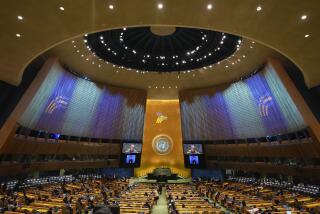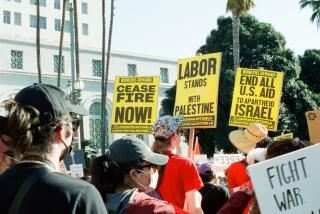But the Shooting Doesnât Stop Until Dec. 10 : Filipinos Rejoice Over Prospects of Cease-Fire
MANILA â Hundreds of supporters of President Corazon Aquino released white doves, lit yellow candles and rejoiced in the prospect of peace Thursday as her government and Communist rebel leaders signed a five-page document calling for 60 days of peace in the insurgency that has left thousands of Filipinos dead.
As tanks and helicopter gunships launched a âmassive military operationâ against the rebels 200 miles north of Manila, government negotiator Ramon Mitra hugged his rebel counterpart, Saturnino Ocampo, in a suburban country club and declared that the peace pact--not scheduled to take effect until Dec. 10--âgives our people a respite from the fratricidal war.
âOur mutual hope as we sign this document is that it will work, . . . that it will lead to a lasting peace.â
President Aquino, who spent a day of prayer and celebration in commemorating the 54th birthday of her slain husband, Benigno S. Aquino Jr., was equally optimistic.
âOur Final Aimâ
âOur final aim is a lasting and honorable peace (wherein) a nation united and free can work for its progress,â the president declared. âIf both sides work in the spirit of a genuine desire for peace, that aim is achievable.â
Outside the club where the agreement was signed, though, there were few signs of that spirit. Instead, the cityâs two afternoon papers reflected the lingering doubt among most Filipinos about whether the first official cease-fire in the 17-year war actually will hold.
âTruce After 17 Years of War,â declared the tabloid Peoples Tonight. Beside it, the lead story in Midday announced, âThe Guns Wonât Be Stilledâ and reported on 11 more killed in a rebel-government clash in the Sierra Madre mountains near Manila.
For weeks, top military commanders and key leftist leaders have expressed doubts about the prospects of the cease-fire accord signed Thursday in front of hundreds of reporters and photographers.
Violations Predicted
Most said that violations are more than likely; that both the government military and the Communist New Peopleâs Army would attempt to exploit the accord in any possible way, and that neither side would approach the continuing negotiations with sincerity.
It would be little better than a Christmas vacation from war, they said, with an extra month off in January for Aquino to campaign for her proposed new national constitution and hold a nationwide charter referendum on Feb. 2.
The agreement has raised the hopes of a nation tired of war; on its face, the pact does form a blueprint for peace. And a closer look at the document shows that, in the very drafting of the accord, both Aquino and the Communist leadership have gained significant political ground.
Aquinoâs victory was both symbolic and substantial. The world media captured the images of the signing ceremony in the same hall where Aquino took her oath of office last February, and the 53-year-old president was again portrayed on five continents as a singular, international symbol of peace.
Follows Decisive Action
The agreement came after Aquino acted decisively for the first time in months--threatening the Communists with âa declaration of warâ last Sunday if they failed to sign a compromise cease-fire within a week.
Nonetheless, for the Communists, too, the cease-fire marked a major political victory--perhaps the most significant since a small group of Marxist students formed the Communist Party of the Philippines and its military arm in 1969.
In laying the foundations for the ongoing negotiations on such basic policy issues as land reform, the U.S. military bases in the Philippines and redistribution of the nationâs wealth, the Communists will be permitted permanent offices in Manila for the first time. They are allowed a legal secretariat. They will be negotiating on an equal political footing with the government, and they are equally represented on national and local cease-fire committees that will be appointed by both sides to police and punish violations of the pact.
The accord also opens the door for extensions of the cease-fire, which could permit the Communist Party and its military representatives a permanent political presence in the capital.
Military Goes Along
Clearly, Aquinoâs senior military commanders approved the accord, although their victories in the peace process are more difficult to determine.
Asked during a recent interview what the military could gain from a cease-fire, a general close to the peace talks said, âWe cannot gain anything from it.â
In reality, though, the 60-day break will give the 200,000-member armed forces an opportunity to regroup and reunite after nine months of widening splits surrounding the conflict between Aquino and former Defense Minister Juan Ponce Enrile, whom Aquino fired in a sweeping Cabinet shake-up last Sunday.
Enrileâs replacement, retired Gen. Rafael Ileto, also plans to use the cease-fire period to launch a propaganda offensive in the remote provinces. Ileto, the former Philippine ambassador to Thailand, where he watched the Thai government put down a similar Communist rebellion by sending its military out to build roads, bridges and modern markets, says the temporary peace represents a golden opportunity for an armed force known for its abuses and torture in the past to improve its popular image.
Enrile, who publicly campaigned against the cease-fire process, has asserted that, in order for it to work, the Communists would have to identify all of their members, which, he conceded, they would never do.
There were other signs of dissent over the cease-fire within Aquinoâs military. Senior military sources leaked to The Times and a few other American journalists a copy of four pages of notes on the negotiations they said was seized from a Communist safehouse in Manila.
The document, signed by the partyâs National Urban Committee and United Front Committee, states that the Communists are using the cease-fire simply as a key step toward their ultimate goal of taking control of the country.
The government is hoping that it can use the cease-fire period to persuade many of the 23,200 armed regulars in the New Peoples Army to lay down their arms and return to mainstream society. But President Aquino, faced with an unprecedented economic crisis, has allocated just $50 million for a program to rehabilitate rebel returnees.
All of her top aides have conceded the sum is at least five times too little to provide an adequate amount of land, seed and fertilizer to get the rebels restarted as farmers. Virtually no new factories have opened to provide new jobs, and the military budget is so constrained that it is unclear just how many roads and bridges the soldiers can afford to build.
More to Read
Sign up for Essential California
The most important California stories and recommendations in your inbox every morning.
You may occasionally receive promotional content from the Los Angeles Times.










